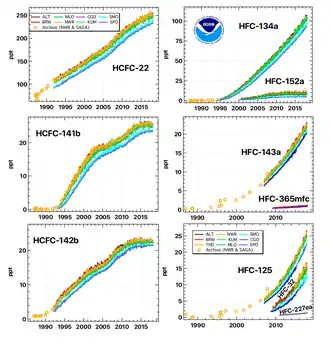R-410A
R-410A, sold under the trademarked names AZ-20, EcoFluor R410, Forane 410A, Genetron R410A, Puron, and Suva 410A, is a zeotropic but near-azeotropic mixture of difluoromethane (CH2F2, called R-32) and pentafluoroethane (CHF2CF3, called R-125) that is used as a refrigerant in air conditioning applications. R-410A cylinders are colored rose.[1][2]
History
R-410A was invented and patented by Allied Signal (now Honeywell) in 1991.[3] Other producers around the world have been licensed to manufacture and sell R-410A, but Honeywell continues to be the leader in capacity and sales.[4] R-410A was successfully commercialized in the air conditioning segment by a combined effort of Carrier Corporation, Emerson Climate Technologies, Inc., Copeland Scroll Compressors (a division of Emerson Electric Company), and Allied Signal. Carrier Corporation was the first company to introduce an R-410A-based residential air conditioning unit into the market in 1996 and holds the trademark "Puron".[5][6]
Availability
R-410A has replaced R-22 as the preferred refrigerant for use in residential and commercial air conditioners in Japan, Europe, and the United States.[7]
Parts designed specifically for R-410A must be used, as R-410A operates at higher pressures than other refrigerants.[8] R-410A systems thus require service personnel to use different tools, equipment, safety standards, and techniques. Equipment manufacturers are aware of these changes and require the certification of professionals installing R-410A systems. In addition, the AC&R Safety Coalition has been created to help educate professionals about R-410A systems.
R-22 Phaseout
In accordance with terms and agreement reached in the Montreal Protocol (The Montreal Protocol on Substances That Deplete the Ozone Layer), the United States Environmental Protection Agency has mandated that production or import of R-22 along with other hydrochlorofluorocarbons (HCFCs) be phased out in the United States. In the E.U. and the U.S., virgin R-22 cannot be used in the manufacture of new air conditioning or similar units from 1 January 2010.[7] In other parts of the world, the phase-out date varies from country to country. Today, all newly manufactured window air conditioners and mini split air conditioners in the United States come with R-410A.[9] Since 1 January 2020, the production and importation of R-22 has been banned; the only available sources of R-22 include that which has been stockpiled or recovered from existing devices.[7]
Precaution
R-410A cannot be used in R-22 service equipment because of higher operating pressures (approximately 40 to 70% higher).
While R-410A has negligible fractionation potential, it can't be ignored when charging.
To avoid fractionation as the system is charged and for optimum system performance, correct type of cylinder has to be used for charging - if cylinder with dip-tubes are used, R-410A can be charged while the cylinder is upright. However, if the cylinder doesn't have dip-tubes, it should be kept upside-down to charge with liquid, not vapor, from the cylinder. The procedure, then, is to fill very slowly, the valve restricting output, in order to avoid slugging the compressor with liquid.
Trade names
- Suva 410A (DuPont).
- Puron (Carrier)
- Genetron AZ-20 (Honeywell)
Physical properties
| Property | Value | ||||
|---|---|---|---|---|---|
| Formula |
| ||||
| Molecular weight (Da) | 72.6 | ||||
| Melting point (°C) | −155 | ||||
| Boiling point (°C) | −48.5 | ||||
| Liquid density (30 °C), kg/m3 | 1040 | ||||
| Vapour density (30 °C), air=1.0 | 3.0 | ||||
| Vapour pressure at 21.1 °C (MPa) | 1.383 | ||||
| Critical temperature (°C) | 72.8 | ||||
| Critical pressure, MPa | 4.90 | ||||
| Gas heat capacity (kJ/(kg·°C)) | 0.84 | ||||
| Liquid heat capacity @ 1 atm, 30 °C, (kJ/(kg·°C)) | 1.8 |
Thermophysical properties - http://twt.mpei.ac.ru/TTHB/2/R410a-eng.html
Environmental effects

Unlike alkyl halide refrigerants that contain bromine or chlorine, R-410A (which contains only fluorine) does not contribute to ozone depletion and is therefore becoming more widely used, as ozone-depleting refrigerants like R-22 are phased out. However, R410A has a high global warming potential (GWP) of 2088, higher than that of R-22 (GWP=1760), and an atmospheric lifetime spanning decades.[13]
Since R-410A allows for higher SEER ratings than an R-22 system by reducing power consumption, the overall impact on global warming of R-410A systems can, in some cases, be lower than that of R-22 systems due to reduced greenhouse gas emissions from power plants. This assumes that the atmospheric leakage will be sufficiently managed.[14]
R-410A use is expanding globally and rapidly.[15] While there is some speculation regarding its retirement, there were no generally accepted alternatives for use in commercial air conditioning systems—especially when flammability is considered—though many companies were researching options.[16] The U.S.-based manufacturer Carrier announced that mildly more efficient and flammable R-454B (GWP=466) will be offered in its products starting year 2023.[17]
References
- https://www.engineeringtoolbox.com/refrigerant-color-codes-d_1681.html
- https://www.airconditioning-systems.com/refrigerant.html
- AZ-20 Story - About R-410A - R-410A - Honeywell AZ-20 Refrigerant Archived 2007-11-16 at the Wayback Machine
- Certification - R-410A - Honeywell AZ-20 Refrigerant Archived 2007-11-25 at the Wayback Machine
- "PURON - Reviews & Brand Information - Carrier Corporation SYRACUSE, NY - Serial Number: 77215886". Trademarkia.com. Retrieved 2016-05-01.
- "Refrigerants". Carrier Corporation. Archived from the original on 31 March 2012.
- EPA R-22 Phase-out
- "R-410A Certification FAQ". Mainstream Engineering Corporation. Retrieved 2009-03-05.
- Honeywell AZ-20 (R-410A) Refrigerant
- "R-410a Material Safety Data Sheet" (PDF). Honeywell International Inc. Archived from the original (PDF) on 2010-10-11. Retrieved 2009-07-03.
- "Puron Refrigerant R-410A" (PDF). Archived from the original on 21 December 2006. Retrieved 2 July 2014.CS1 maint: bot: original URL status unknown (link)
- "R-410A" (PDF). Honeywell Refrigerants Europe. Archived from the original (PDF) on 27 March 2014. Retrieved 26 April 2013.
- IPCC Assessment Report 4 (AR4) 2007
- "The Essentials Of Working With R-410A" (PDF). Florida State College at Jacksonville. p. 7. Archived from the original (PDF) on September 4, 2014. Retrieved November 21, 2013.
- "Global R410A Market 2020 Growth Analysis...Showing Impressive Growth by 2026". marketwatch.com. 2020-08-15.
- "What future for R410A?". Cooling Post. 2015-08-26.
- "Carrier picks R454B for ducted ac". Cooling Post. 2018-12-19.
